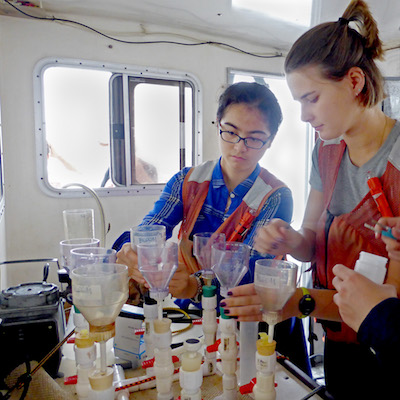Colby College Students Engage in Genetic Study of Toxic Algae
An unprecedented harmful algal bloom off the coast of New England this fall provided a unique opportunity for Colby College students studying at Bigelow Laboratory for Ocean Sciences.
Each fall, our scientists host a group of undergraduate students for a semester-in-residence program that provides an immersive, hands-on experience with marine research. One of the most memorable aspects of the semester is the series of research cruises they conduct along the Damariscotta River, which runs alongside our campus and out to sea.
It's common for the students to detect a bloom of toxic marine phytoplankton from the genus Pseudo-nitzschia on these cruises – small blooms are part of the normal phytoplankton cycle along the coast of Maine. However, something very different occurred this year.
A large bloom of the harmful algae was detected near the border of Canada and steadily spread, causing regulators to temporarily close shellfisheries as far south as Rhode Island. While our Bigelow Analytical Services team worked with Maine's Department of Marine Resources to measure and monitor the bloom, Senior Research Scientist Peter Countway worked with the students to assess the abundance of the algae through advanced genetic tools.
"This fall's Pseudo-nitzschia bloom gave us the opportunity to get the Colby semester students hands-on with a cutting-edge molecular technique and engage them with a critical, real-world problem," Countway said.
Pseudo-nitzschia is difficult to count by looking at a seawater sample through a microscope. As a diatom, the phytoplankton forms in long, tangle-prone chains. Countway uses a polymerase chain reaction (PCR) technique that detects and counts the copies of a gene that is specific to Pseudo-nitzschia. The students collected samples at set distances and depths on their Damariscotta River research cruises. Once back in the lab, they could use the PCR technique to analyze the samples.
"Rather than spending days looking through a microscope and manually counting," Countway said, "we can use this method to assess the relative abundance of Pseudo-nitzschia down the entire river in about 90 minutes."
There are, however, a couple key limitations of this method. While the test accurately counts the copies of the specific gene they are looking for, scientists don't yet know how many copies reside in each cell of the algae. Additionally, there are about a dozen species of Pseudo-nitzschia in the Gulf of Maine. Not all of them are toxic, and this method can't tell them apart. What the method does provide is a measurement of the relative abundance – how much more or less of the genes are present compared to other times that samples were analyzed.
As is often the case with scientific research, multiple methods are needed to complete the picture. One of those methods is being carried out through a collaborative partnership with Kate Hubbard of the Florida Fish and Wildlife Research Institute. While her method can't provide Countway's information about the overall abundance, it can tell how many different species of Pseudo-nitzschia are in a sample and what proportion of the population each represents.
The other critical piece of missing information regards the toxicity of the different Pseudo-nitzschia species, and Countway again turned to the Colby College students to start working toward that answer.
Julia Park is a junior at Colby College. For her Bigelow Laboratory semester research project, she worked with Countway and Nicole Poulton, another scientist at Bigelow Laboratory, to grow about a dozen Pseudo-nitzschia cultures from cells captured in seawater samples.
"When working on a lab assignment at school, you do an experiment and normally know what the answer is going to be," Park said. "It's really valuable to get to work on a project like this, because the information you know and the questions you need to answer change as the situation develops."
During the next few months, our scientists will use the cultures to determine the toxicity of the different Pseudo-nitzschia species collected this fall. Some can produce the toxin in response to environmental stimuli, but others are harmless. Park and Countway have already conducted DNA sequencing on several of the cultures, identifying them as one of the known toxin-producing species, Pseudo-nitzschia pungens. The cultures will also provide an opportunity to investigate the exact environmental conditions that trigger toxin production in some species of the algae.
"The only way we're going to be able to understand Pseudo-nitzschia and forecast when harmful blooms might occur is by merging an understanding of each species' genetic identification with a clear definition of their physical appearance and potential for toxin production," Countway said. "Our response to this year's Pseudo-nitzschia bloom will help to characterize the physiology and ecology of this species along the coast of Maine so we're prepared to deal with similar events in the future."
Bigelow Laboratory's response to this fall's Pseudo-nitzschia bloom was made possible through Rapid Response funding from NOAA, which also provided similar funds to Woods Hole Oceanographic Institution to coordinate and collaborate with our Laboratory.

